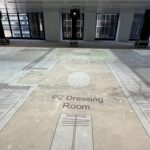Have you ever seen a building come to life, its walls dancing with vibrant colors and mesmerizing patterns? That’s the magic of projection mapping, a cutting-edge technology that’s revolutionizing the world of visual arts and entertainment. In this comprehensive guide, we’ll dive deep into the world of projection mapping, exploring its history, applications, and the incredible possibilities it offers for creative expression.

What is Projection Mapping?
Projection mapping, also known as video mapping or spatial augmented reality, is a technology that turns ordinary objects into interactive displays. It uses specialized software to warp and mask projected images to fit perfectly onto irregularly shaped surfaces. The result? Mind-bending visual experiences that blur the line between the physical and digital worlds.
A Brief History of Projection Mapping
While it might seem like a recent innovation, the roots of projection mapping go back further than you might think:
1969: Disney introduces the Haunted Mansion ride, featuring singing busts created with an early form of projection mapping.
1980s: Large-scale projections on buildings become more common in public art installations.
1990s: Advancements in video projection technology make more complex mappings possible.
2000s: The term “projection mapping” is coined, and the technique gains popularity in advertising and entertainment.
2010s onwards: Projection mapping becomes more accessible and widespread, used in everything from music videos to architectural installations.
How Does Projection Mapping Work?
At its core, projection mapping involves these key steps:
- Surface Analysis: The target surface is scanned or modeled to create a digital replica.
- Content Creation: Artists design visual content specifically for the surface.
- Mapping: Software is used to map the content onto the digital model of the surface.
- Projection: High-powered projectors display the mapped content onto the physical surface.
The technology behind projection mapping has come a long way. Today, advanced software like MadMapper, Resolume, and TouchDesigner make it possible to create complex, interactive mappings with relative ease.
Applications of Projection Mapping
The versatility of projection mapping has led to its use in a wide range of fields:
- Entertainment and Live Events
From concert stages to theme park rides, projection mapping adds an extra layer of spectacle to live performances. Artists like Beyoncé and Pink Floyd have used it to create unforgettable visual experiences during their shows. - Advertising and Marketing
Brands are using projection mapping to create eye-catching displays that turn products or buildings into canvases for storytelling. For example, Nokia famously projection mapped their logo onto the Millbank Tower in London for a product launch. - Architecture and Interior Design
Projection mapping can temporarily transform the appearance of buildings or interior spaces, allowing for dynamic, changeable designs. The Sydney Opera House’s annual Vivid Festival is a stunning example of architectural projection mapping. - Art Installations
Artists are using projection mapping to create immersive, interactive experiences that challenge our perception of space and reality. TeamLab’s digital art museums in Tokyo and other cities showcase the artistic potential of this technology. - Education and Museums
Museums and educational institutions are using projection mapping to bring exhibits to life and create more engaging learning experiences. The Cleveland Museum of Art’s ARTLENS Gallery uses projection mapping to help visitors interact with artworks in new ways.
For more examples of innovative projection mapping projects, check out this gallery from Projection Mapping Central: https://projection-mapping.org/projection-mapping-gallery/
The Technical Side of Projection Mapping
Creating a successful projection mapping project involves several technical considerations:
- Projectors
The choice of projector is crucial. Factors to consider include:
- Brightness (measured in lumens)
- Resolution
- Contrast ratio
- Throw ratio (the relationship between the projector’s distance from the surface and the size of the image)
- Software
Specialized software is used to create and map content. Popular options include:
- MadMapper
- Resolume
- TouchDesigner
- Watchout
- Content Creation
The visual content is typically created using 3D animation software like Cinema 4D, Maya, or Blender, combined with video editing tools like After Effects. - Audio
Many projection mapping installations incorporate sound, requiring careful audio design and synchronization.
Challenges and Considerations
While projection mapping offers incredible creative possibilities, it also comes with its share of challenges:
- Environmental Factors
Outdoor installations must contend with ambient light and weather conditions. Proper planning and powerful projectors are essential. - Surface Complexity
Irregular or complex surfaces require more sophisticated mapping techniques and can limit the types of content that work well. - Technical Expertise
Creating high-quality projection mappings requires a combination of artistic vision and technical skill. - Cost
High-end projectors and software can be expensive, although costs are coming down as the technology becomes more widespread.
The Future of Projection Mapping
As technology continues to advance, we can expect to see even more exciting developments in projection mapping:
- Increased Interactivity
Projection mapping installations are becoming more responsive to audience interaction, creating truly immersive experiences. - Integration with AI and Machine Learning
AI could enable more dynamic, adaptive projections that respond to their environment in real-time. - Improved Portability
Advancements in projector technology are making it easier to create impressive mappings with smaller, more portable equipment. - Expanded Applications
We’re likely to see projection mapping used in new and unexpected ways, from enhancing virtual reality experiences to creating dynamic urban lighting solutions.
For more insights into the future of projection mapping, check out this article from Panasonic: https://na.panasonic.com/us/trends/future-projection-mapping-how-technology-evolving
Conclusion
Projection mapping is more than just a visual trick – it’s a powerful tool for transforming spaces, telling stories, and creating immersive experiences. Whether you’re an artist looking to push the boundaries of your craft, a marketer seeking to create unforgettable brand experiences, or simply someone fascinated by the intersection of technology and creativity, projection mapping offers a world of possibilities to explore.
As this technology continues to evolve, we can look forward to even more stunning and innovative applications that challenge our perceptions and ignite our imaginations. The future of projection mapping is bright indeed – and it’s lighting up the world around us in ways we never thought possible.






